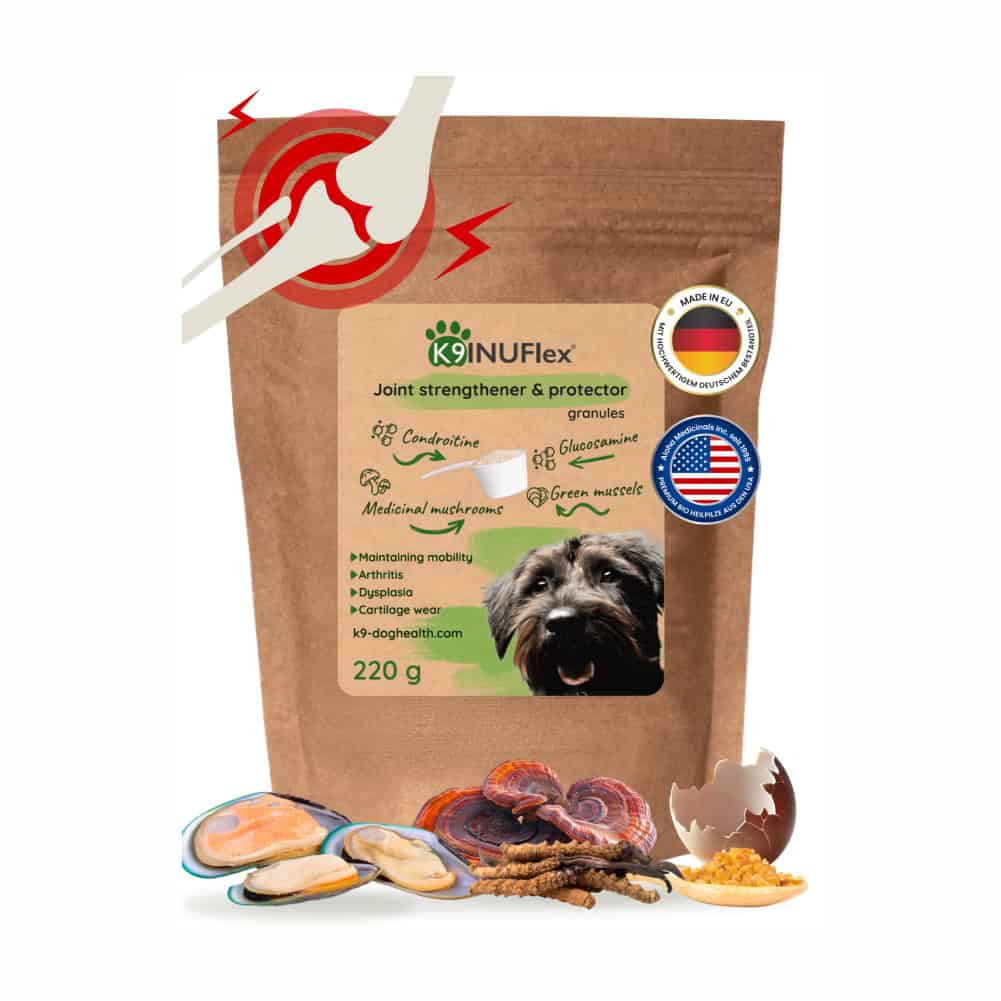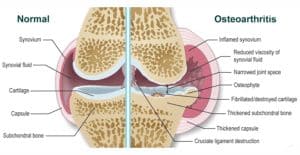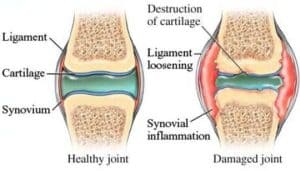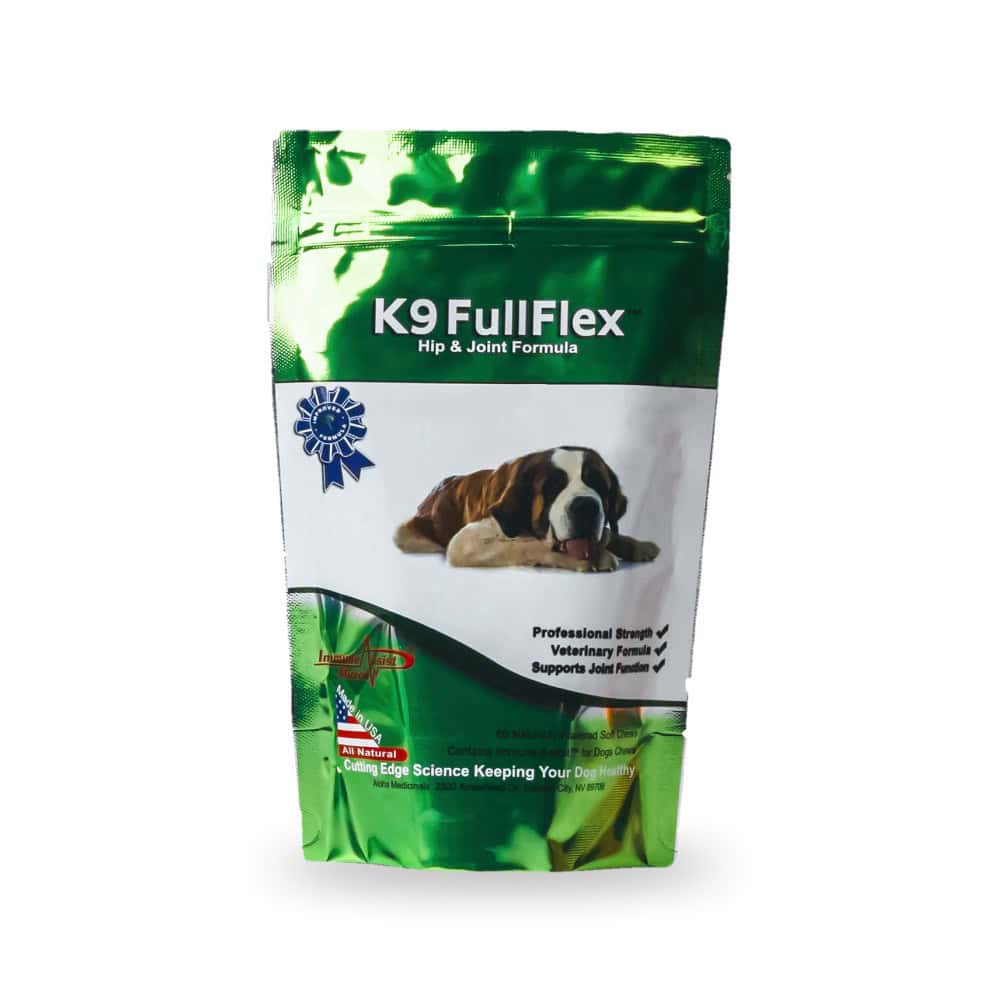Arthritis in dogs – Symptoms, treatment, and prevention
Arthritis in dogs is one of the most common musculoskeletal conditions, leading to pain, stiffness, and reduced mobility, especially in senior dogs. Although it cannot be completely cured, the right treatment, nutrition, and joint-support supplements can ease symptoms and help your dog stay active, happy, and pain-free for years to come.
What is arthritis in dogs?
Arthritis in dogs is an inflammatory process that damages the cartilage covering the ends of bones and the synovial membrane within the joint. As the disease progresses, the cartilage gradually becomes thinner, and as a result, the joint space narrows. Consequently, painful friction occurs between the bones, leading to stiffness, inflammation, and reduced movement. While most cases appear in older dogs, younger ones can also develop arthritis after injuries or due to genetic predisposition.
Depending on the cause, arthritis can be degenerative, autoimmune, or inflammatory. Identifying the underlying form helps determine the most effective treatment strategy.
Main types of arthritis in dogs
Osteoarthritis: degenerative joint disease
Osteoarthritis is the most common type of canine arthritis. As the condition progresses, the protective cartilage gradually wears away, and as a result, the bones begin to rub directly against each other. This friction, in turn, triggers inflammation, pain, and stiffness. Over time, bone spurs (osteophytes) may also form, thereby worsening discomfort and further limiting mobility.
Rheumatoid arthritis: autoimmune joint inflammation
Rheumatoid arthritis is less common but can develop even in young dogs. It occurs when the immune system mistakenly attacks joint tissues, causing chronic inflammation, pain, and swelling. Multiple joints—such as the ankles, elbows, or knees—are often affected simultaneously.
Symptoms of arthritis in dogs
- Limping, stiffness, or reluctance to move
- Avoiding stairs, jumping, or active play
- Stiffness after rest that eases with movement
- Loss of interest in walks or play
- Swelling or warmth around joints
- Fatigue and mood changes
How is arthritis in dogs diagnosed?
Veterinarians diagnose arthritis using physical exams and imaging techniques. X-rays and ultrasound reveal cartilage thinning and inflammation. In more complex cases, CT or MRI scans may be necessary. Arthroscopy—an endoscopic examination of the joint—can also provide a direct look at the joint’s interior structure and damage.
Treatment of arthritis in dogs
The main treatment goals are to reduce inflammation, relieve pain, and maintain joint mobility. While arthritis cannot be completely cured, effective management can greatly improve your dog’s comfort and movement.
Proper diet
A balanced, anti-inflammatory diet plays a vital role in managing arthritis in dogs. Foods rich in omega-3 fatty acids, antioxidants, and collagen help regenerate cartilage, while maintaining a healthy body weight reduces stress on the joints.
Natural anti-inflammatory remedies
Among natural options, Boswellia serrata (Indian frankincense) is one of the most effective anti-inflammatory herbs for canine arthritis. In fact, research has shown that it safely reduces inflammation and pain without causing side effects on the dog’s system. Therefore, it is often recommended as a gentle yet powerful natural alternative to conventional pain relief.
1. Glycosaminoglycans and green-lipped mussel extract
Glucosamine and chondroitin sulfate help repair cartilage and, in addition, support joint fluid production. As a result, they improve flexibility and reduce stiffness in affected joints. The New Zealand green-lipped mussel and ESM are natural and highly bioavailable sources of these key nutrients. Moreover, they provide long-term support for cartilage regeneration and overall joint comfort.
2. Omega-3 fatty acids
Omega-3 fatty acids (EPA and DHA) have proven anti-inflammatory benefits and, consequently, support healthy cartilage metabolism. Furthermore, they help maintain joint lubrication and reduce oxidative stress. Regular supplementation – such as with K9 INUKrill® – can lead to visible improvement within just two months. For this reason, omega-3s are often a cornerstone of natural joint care plans for dogs.
3. Maintaining an ideal weight
Keeping your dog at a healthy weight reduces pressure on the joints and slows cartilage wear. Weight management is one of the most effective ways to protect joint health and prevent further damage.
4. Exercise and physiotherapy
Gentle, regular movement stimulates joint lubrication and, as a result, helps maintain flexibility. In addition, low-impact activities such as swimming, walking on soft ground, and guided physiotherapy sessions are all highly beneficial. However, it’s important to avoid slippery surfaces and high-impact actions like jumping or running on hard floors, as these can worsen joint strain and pain over time.
Complementary natural therapies
Alongside conventional medication, several natural therapies can further ease the symptoms of arthritis in dogs. Together, these methods improve mobility, reduce pain, and support long-term recovery. Moreover, they enhance a dog’s overall sense of well-being and help maintain muscle strength.
- Physiotherapy: targeted exercises strengthen muscles, thereby improving joint stability and restoring range of motion.
- Hydrotherapy: swimming provides low-impact exercise that strengthens muscles, improves circulation, and at the same time reduces pressure on the joints.
- Massage: stimulates blood flow, reduces stiffness, and consequently helps muscles relax and recover faster.
- Acupuncture: promotes endorphin release, which in turn naturally relieves pain and improves overall flexibility.
Arthritis in senior dogs – the emotional aspect
Older dogs are often more sensitive to pain and reduced mobility, which in many cases can affect their mood and confidence. Therefore, it’s essential to show patience, offer comfort, and maintain gentle daily activity to support their emotional well-being. For this reason, short walks, soft bedding, and above all, affectionate interaction play a key role in keeping their spirits high and helping them enjoy life despite arthritis.
How to prevent arthritis in dogs
- Maintain your dog’s ideal body weight
- Provide joint-support supplements regularly
- Avoid sudden movements and slippery floors
- Feed a balanced, omega-3-rich diet
- Visit your veterinarian for regular check-ups
Arthritis in dogs cannot be reversed, but with proper nutrition, natural supplements, and regular exercise, your pet can live a long, happy, and pain-free life.
Frequently asked questions about arthritis in dogs (FAQ)
❓ What are the first signs of arthritis in dogs?
The earliest signs of arthritis in dogs often include stiffness after rest, limping, or reluctance to climb stairs or jump. In addition, many dogs start moving more slowly, hesitate before standing up, or seem tired even after short walks. Therefore, if you notice any of these changes, it’s best to consult your veterinarian for an early diagnosis and proper treatment.
❓ At what age do dogs usually develop arthritis?
Canine arthritis most commonly appears in middle-aged and senior dogs, usually from the age of seven. However, younger dogs can also develop it after injuries or due to genetics. For example, Labradors, German Shepherds, and Golden Retrievers are among the breeds most at risk. As a result, starting joint support early can greatly reduce the likelihood of arthritis later in life.
❓ Can arthritis in dogs be cured?
Unfortunately, arthritis in dogs cannot be completely cured because cartilage damage is irreversible. However, the symptoms can be effectively managed with the right care. With proper nutrition, natural joint-support supplements, and regular gentle exercise, many dogs live long and happy lives. In addition, frequent veterinary check-ups help adjust treatment as your dog’s needs change.
❓ What is the best natural remedy for arthritis in dogs?
Among the most effective natural remedies for arthritis in dogs are Boswellia serrata (Indian frankincense), green-lipped mussel extract, and eggshell membrane (ESM). Each of these ingredients helps reduce inflammation and support cartilage regeneration. Moreover, they are safe for long-term use and often show visible results within weeks. When combined with omega-3 fatty acids and a healthy diet, they provide excellent joint protection.
❓ Is arthritis painful for dogs?
Yes, arthritis in dogs is painful and progressive. As the disease advances, inflammation and cartilage wear lead to discomfort and stiffness. However, with consistent care, pain can be significantly reduced. In conclusion, combining medication, supplements, and gentle exercise allows dogs to enjoy a much better quality of life.
Recommended reading
To explore natural joint support, check out our guide on Eggshell membrane (ESM) for dogs. If your dog also struggles with digestion, our Dog diarrhea – causes and solutions article might be helpful.
For dogs with allergies, read Dog allergy – symptoms and treatment options. For senior dogs, discover Immune support for senior dogs to maintain vitality and health.
You may also find our Joint support for dogs guide useful—it explains the most effective natural supplements. For information about dysplasia, read Symptoms and treatment of dysplasia.
Important:
This article on arthritis in dogs is for informational purposes only and does not replace veterinary diagnosis or treatment. Always consult your veterinarian for an accurate diagnosis and suitable therapy.
References:
- McCarthy, G., et al. (2007). Randomised double-blind, positive-controlled trial to assess the efficacy of glucosamine/chondroitin sulfate for the treatment of dogs with osteoarthritis. The Veterinary Journal, 174(1), 54–61.
- Sengupta, K., et al. (2018). Clinical evaluation of a Boswellia serrata extract in canine osteoarthritis. Journal of Ethnopharmacology, 209, 39–46.
- Comblain, F., et al. (2011). Review of dietary supplements for the management of osteoarthritis in dogs in studies from 2004 to 2011. The Veterinary Journal, 189(2), 141–146.
- Roush, J. K., et al. (2010). Evaluation of the effects of dietary supplementation with fish oil omega-3 fatty acids on weight bearing in dogs with osteoarthritis. Journal of the American Veterinary Medical Association, 236(1), 67–73.
- Zapata, A., & Fernández-Parra, R. (2023). Management of Osteoarthritis and Joint Support Using Feed Supplements: A Scoping Review of Undenatured Type II Collagen and Boswellia serrata. Animals, 13(5), 870.
- Millis, D. L., & Levine, D. (2014). Canine Rehabilitation and Physical Therapy (2nd ed.). Elsevier Health Sciences.







